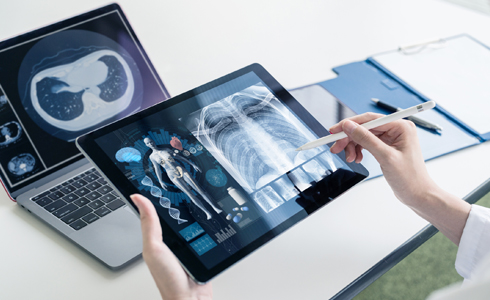Modernize virtual care and improve the quality of delivery
From IT infrastructure to integration and interoperability, the success of your telehealth services relies on having the right technology and expertise to make them work. Count on Zones.
An increasingly tech-savvy population has greater expectations for technology's role in healthcare delivery. They expect convenience, easy access, and quick responses. This has healthcare organizations doing their best to further optimize telehealth services.
Like other areas of your healthcare digital transformation, Zones has the expertise to overcome the technical challenges impinging your success, including:
Cost and resources to deploy, manage, and support
Cybersecurity, authentication, and access controls
Interoperability with electronic health records (EHR)
Networking and wireless connectivity
Why Partner with Zones?
As your IT partner, Zones can take care of the technology challenges while you take care of your patients and other healthcare priorities.
Our dedicated HCIT team of experts can help you achieve your telehealth and other key digital initiatives through solution consulting and diverse professional and managed services. And when IT headcount is limited but time is critical, we also offer strategic IT staffing services.
Our customer-first approach starts with listening.
It's only by first understanding your current IT environment and goals for telehealth and virtual care services that collaboration can begin. We can help you select, procure, implement and support the hardware, software, and services you need to deliver a comprehensive, cloud-based platform for telehealth and virtual care that may include:
Virtual visits
Virtual rounding
Remote patient monitoring (RPM)
Remote consultation and clinical collaboration
Remote reading and teleradiology using PACS medical imaging
Tele-education
Electronic health record (EHR) system interoperability
From initial assessment and design to implementation and management, Zones' end-to-end services and proven process take the worry out of installing and optimizing telehealth solutions that benefit patient outcomes, clinician satisfaction, and healthcare operations.
How Telehealth Helps Promote and Facilitate Continuity of Care
Telehealth can improve healthcare quality and make it accessible to more people. It can also improve care experiences for providers and patients, resulting in better care and engagement, increased patient satisfaction and provider ratings, and greater operational efficiency.
Electronic health record (EHR) integration
Integration of the EHR within telehealth applications has yielded many benefits, including:
Improved patient care and outcomes
Increased patient participation
More seamless care coordination
Higher caregiver satisfaction
Enhanced practice efficiencies and cost savings1

Telemedicine
Virtual visits
When face-to-face care isn't required, virtual visits make healthcare more accessible for patients and cost-effective for providers. Virtual technology is essential to the continuity of care for at-risk patients and others who can't make an in-person visit or who prefer a virtual visit for convenience, especially people with mobility challenges or who live in rural areas.
This flexibility increases patient engagement and leads to greater patient satisfaction and a higher healthcare provider rating.

HIPAA-compliant video conferencing software enables patients to receive remote care for non-urgent conditions. It can also help expedite in-hospital point-of-care scenarios where additional consultation is needed but a medical specialist isn't readily available onsite. For example, emergency departments may utilize a mobile device or telehealth workstation to expedite a remote psychiatric consult for a patient presenting with symptoms of mental health problems.

Teleradiology and remote reading stations enable radiologists to provide timely and convenient reporting of exams, so providers can deliver care and treatment. They can also share medical images and information with other healthcare professionals safely and more efficiently.
Remote care management

Hospitals can reduce costs and save time while still providing high-quality care through remote patient monitoring (RPM) and virtual rounding solutions.
Tele-education

Tele-education or distance learning uses information and communication technologies to facilitate continuing training and medical education for your staff.

Tele-education is also valuable for patients and their families – for example, to receive training on how to administer an injection.
Our Strategic Partnerships Give You Greater Flexibility
We're not locked into one brand or one solution. You shouldn't be, either. Our strategic partnerships with leading healthcare IT companies mean we can devise the right solutions and services to fit your needs today and ambitions for the future.
FEATURED PARTNERS















Telehealth is another way digital technology has transformed care services. Zones' IT services and expertise help ensure you maximize the quality of care delivery.
Sources:
1. Jill McKeon, "Benefits of EHRs." HealthIT.gov (accessed July 20, 2022).


 Healthcare Solutions
Healthcare Solutions